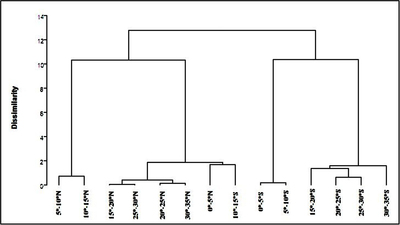Upadhyaya, H D and Reddy, K N and Singh, Sube and Gowda, C L L and Irshad Ahmed, M and Ramachandran, S (2014) Latitudinal patterns of diversity in the world collection of pearl millet landraces at the ICRISAT genebank. Plant Genetic Resources, 12 (1). pp. 91-102. ISSN 1479-263X
|
PDF (Author's version post-print)
- Accepted Version
Download (339kB) | Preview |
|
![[img]](http://oar.icrisat.org/7068/2.hassmallThumbnailVersion/Figure%20S1.jpg)
|
Image (JPEG) (Figure)
- Supplemental Material
Download (131kB) | Preview |
|
|
Microsoft Word (Table1-4)
- Supplemental Material
Download (35kB) |
||
|
Microsoft Word (TablesS1-S2)
- Supplemental Material
Download (40kB) |
||
|
PDF
- Published Version
Restricted to ICRISAT users only Download (124kB) | Request a copy |
Abstract
The genebank at ICRISAT, Patancheru, India conserves a total of 19,063 pearl millet landraces from latitudes ranging from 33.00° in the Southern Hemisphere (SH) to 34.37° in the Northern Hemisphere (NH). In the present study, the NH was found to be the major region for growing pearl millet landraces (80.5%). More landraces were found at lower latitudes ( < 20°) in both hemispheres than at higher latitudes. The latitude range of 10°–15° in the NH and 15°–20° in the SH were found to be important source regions for the prevalence of pearl millet, with 39.6% and 13.1% in the world collection of landraces, respectively. Landraces from lower-latitude regions on either side of the equator varied widely for all traits. Landraces from the 5°–10°N latitude region flowered late and grew tall in the rainy and post-rainy seasons and produced more tillers. Landraces from the 10°–15°N latitude region produced few tillers and had long and thick panicles with larger seeds. Long-bristled bird-resistant landraces were considerable at latitudes of 10°–15°S and 20°–25°S. The minimum temperature at the collection sites was found to be one of the important factors for determining the patterns of the prevalence of pearl millet across the latitudes. Late-maturing, tall and high-tillering landraces from lower-latitude regions were better sources for fodder production. Early-maturing landraces producing long and thick panicles with large seeds from mid-latitude regions (15°–20°) in both hemispheres were useful for developing high-yielding cultivars. Using the latitudinal patterns of diversity in pearl millet landraces, missions may be launched to explore high-diversity, under-collected and threatened areas for the collection of materials of interest at latitudes of 15°–20°.
| Item Type: | Article |
|---|---|
| Divisions: | RP-Grain Legumes |
| CRP: | CGIAR Research Program on Grain Legumes |
| Uncontrolled Keywords: | Climate, Collection, Diversity, Landraces, Latitude, Hemisphere |
| Subjects: | Mandate crops > Millets Others > Genetics and Genomics |
| Depositing User: | Mr Siva Shankar |
| Date Deposited: | 27 Aug 2013 04:06 |
| Last Modified: | 19 Aug 2016 04:32 |
| URI: | http://oar.icrisat.org/id/eprint/7068 |
| Official URL: | http://dx.doi.org/10.1017/S1479262113000348 |
| Projects: | UNSPECIFIED |
| Funders: | UNSPECIFIED |
| Acknowledgement: | UNSPECIFIED |
| Links: |
Actions (login required)
 |
View Item |


 Altmetric
Altmetric Altmetric
Altmetric